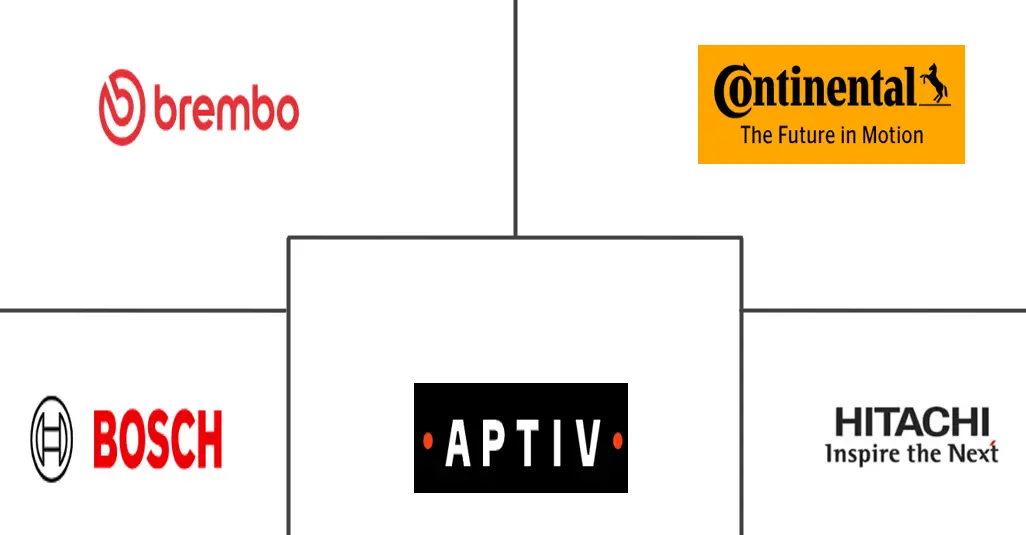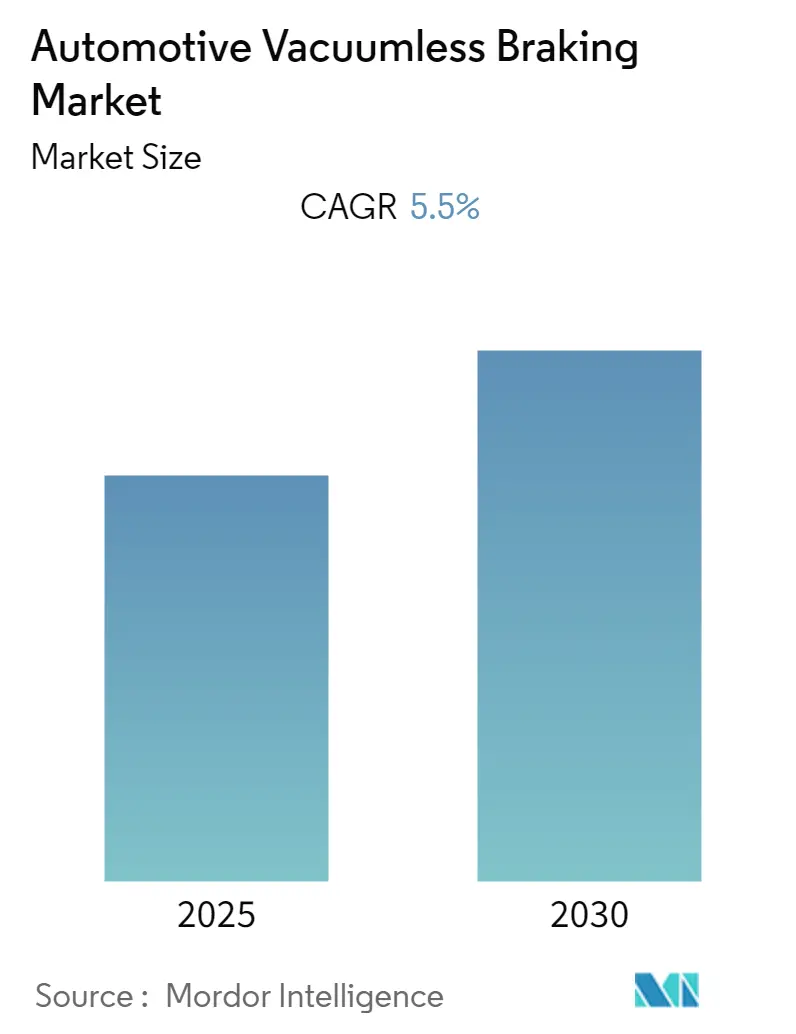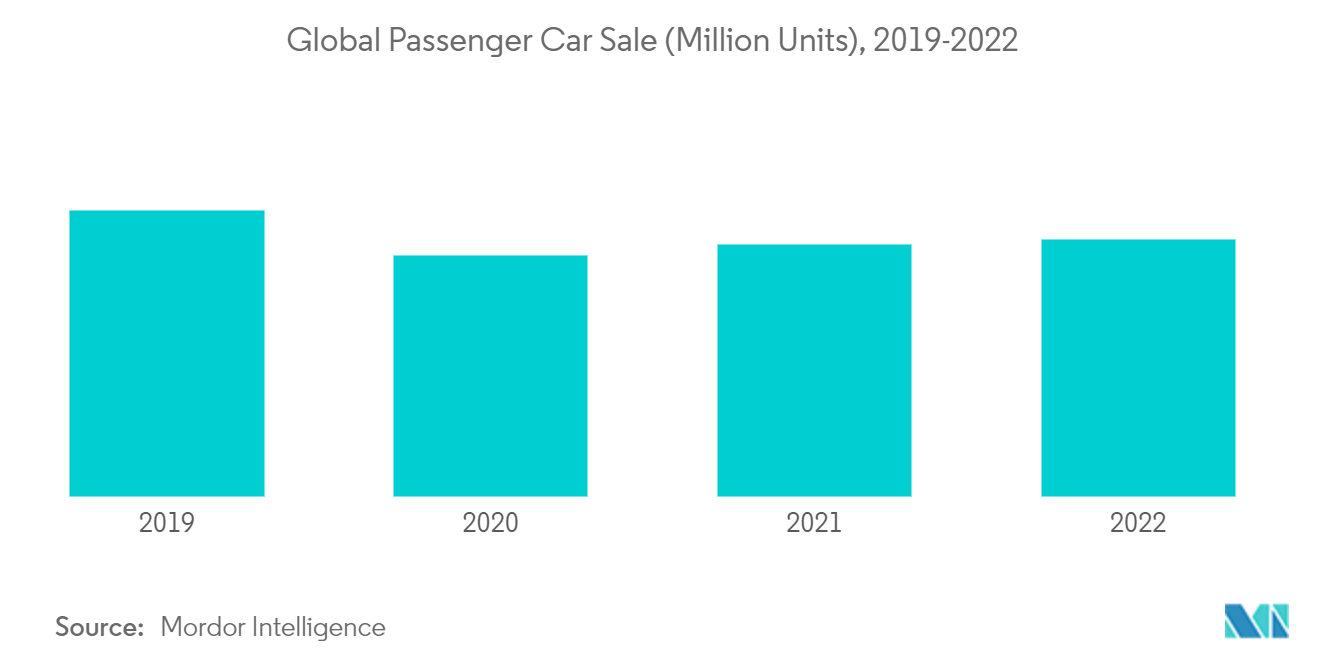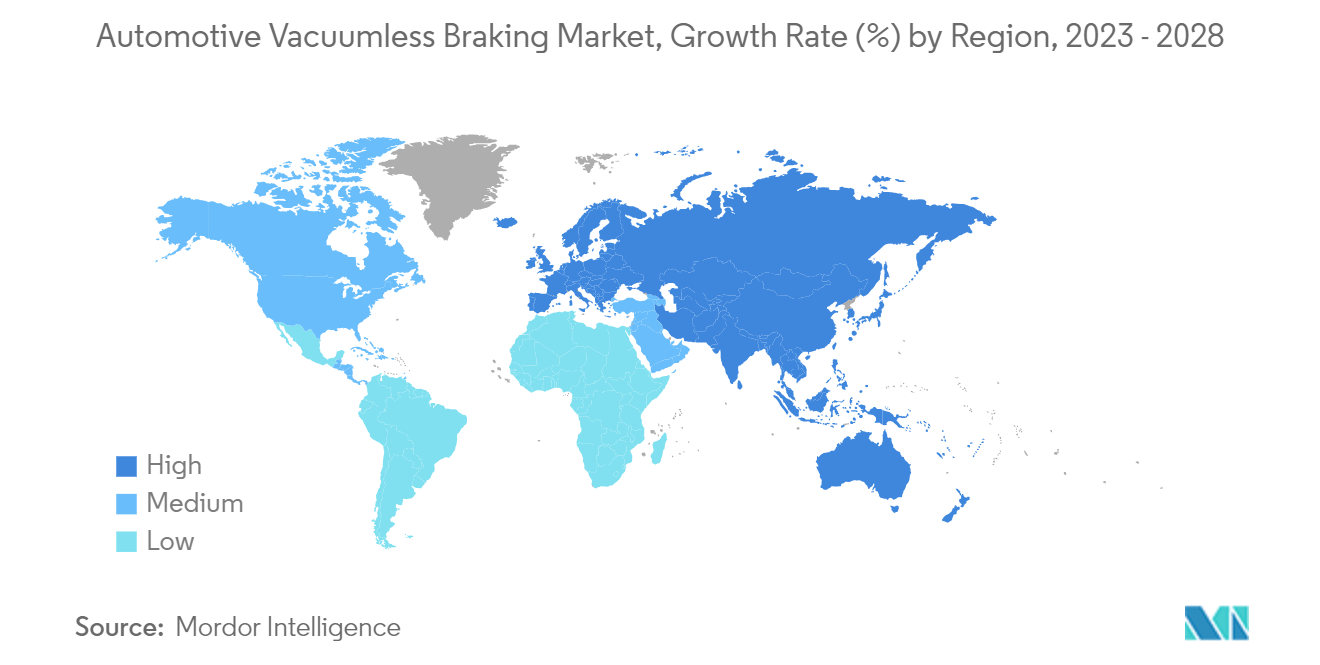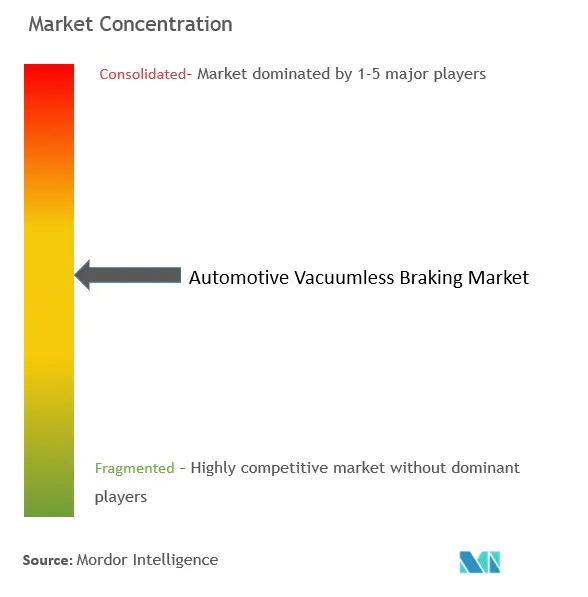Automotive Vacuumless Braking Market Analysis
The Automotive Vacuumless Braking Market is expected to register a CAGR of 5.5% during the forecast period.
Over the medium term, the major factor propelling the development of brake technology is the demand for weight reduction per wheel for improved efficiency and recovery and dissipation of heat through regenerative braking. The growth in autonomous vehicles that will need intensive smart use of brake and steering technology is expected to positively affect the market.
The emergence of hybrid and electric drives over conventional engines, in addition to driver assistance systems, has the requirement of vacuumless braking solutions for the braking system. The industry is growing due to the increased manufacturing of passenger cars, trucks, buses, and other commercial vehicles. The market value is positively impacted by increasing road conditions and the construction of new ones, as well as expanding infrastructure development initiatives.
The electric-assist braking is supporting the growth of automated driving. As cars are becoming automated, electric brake operates the brakes precisely. An electric boost can form hydraulic pressure more quickly, which in turn is likely to witness major growth for the market during the forecast period.
Automotive Vacuumless Braking Market Trends
Passenger Cars is expected to hold the major share in Vacuumless Braking Market
A rise in the sale of passenger car sales across the globe is likely to enhance the demand for passenger cars across the globe. In 2022, around 57.48 million passenger cars were sold across the globe, which witnessed a 2% growth in sales as compared to 2021.
Additionally, an increase in disposable income and technological innovation drives growth in the market studied. The significant increase in the number of luxury vehicles and the decrease in consumer preference for sedans and SUVs have boosted the global demand for passenger cars and their premium amenities.
Furthermore, in response to growing environmental concerns and rising gasoline prices, top luxury automobile manufacturers are launching electrified models of their vehicles. This will also likely aid in the expansion of the market studied.
OEM and state government are working together to robust the hybrid vehicle technology in India. This has helped India's hybrid vehicles market gain significant traction during the assessment period. For instance,
- In August 2022, Toyota Motors announced that it was to invest Rs. 3,600 crores (USD 432946) for manufacturing a hybrid vehicle facility in Karnataka at the Bidai facility. Moreover, the investment plan came out after the State government provided a green signal to start the production of hybrid vehicles.
Indian companies are also working on research and development activities to develop new products that would positively impact the target market growth during the forecast period. For instance,
- In August 2022, India's largest automaker, Maruti Suzuki, confirmed that it shall soon introduce its first electric vehicle by 2025 end. In addition, Its parent firm, Suzuki Motor Corporation, is looking forward to investing Rs 10,400 crore (USD 1250768) in Gujarat to build a manufacturing plant to produce electric vehicles.
With the development mentioned above across the globe, the passenger cars market is likely to witness major growth during the forecast period.
Asia-Pacific being the Fastest Growing Market
In the automotive vacuumless braking market, the growth of the Asia-Pacific region is expected to be more during the forecast period. China, India, and Japan are the major economies in the regional market that are anticipated to grow at a faster rate in the global market. China is one of the biggest automotive markets in the world.
The growing population and rising disposable incomes of people in China have increased the demand for vehicles in the country. Additionally, the low production costs in China have favored the growth of vehicle manufacturing in China. In 2022, China produced 26.86 million passenger and commercial vehicles.
The automotive vacuumless braking manufacturers are doing partnerships with other market participants to develop next-generation braking systems for their future vehicles. For instance,
- In June 2021, Bosch announced at its annual press conference that it would start manufacturing the "iBooster' electric brake booster in Japan in the latter half of 2022. 2021 marked the 110th anniversary of Bosch's business start in Japan. iBooster is a modern braking system that realizes high-performance braking functions such as compatibility with vacuumless systems, customized pedal feeling, improved collision damage mitigation braking performance, and redundancy under automated driving.
The Indian economy is expanding as there is a rise in the disposable income of middle-class consumers. This, in turn, has a favorable impact on the increasing demand for automobiles. Vehicle manufacturing has increased rapidly over the last five years as a result of the country's cheap production costs. The automotive sensor market is gaining traction as vehicle manufacturing increases.
With the growing modernization of vehicles in the country and the rise in safety standards in line with international standards, the average age of vehicles in the country is increasing, which would enhance the demand for vacuumless brakes in the aftermarket segment.
Automotive Vacuumless Braking Industry Overview
The automotive vacuumless braking market is consolidated and majorly dominated by a few players, such as Robert Bosch Gmbh, Brembo S.p.A., Continental AG, and Aptiv PLC, amongst others. Factors like advanced technology, growing investment in R&D projects, and a growing market of electric and autonomous vehicles highly drive the market. To provide more quicker brake response to the driver, major automotive vacuumless braking manufacturers are developing future brake technology and expanding their market reach. For instance,
In September 2022, Robert Bosch started production of the iBooster electric brake booster began at the Tochigi Plant. The company invested USD 0.022 billion (JPY 3 billion) in the Tochigi Plant, which manufactures ABS (antilock braking system) and ESC (electronic stability control), to install production facilities and set up a dedicated production line for the iBooster. iBooster realizes high-performance braking functions such as compatibility with vacuumless systems.
In July 2022, BMW introduced a vacuumless braking system in BMW M models. Through this system, the company enhanced its vehicle performance.
Automotive Vacuumless Braking Market Leaders
-
Continental AG
-
Robert Bosch GmbH
-
Brembo S.p.A.
-
Aptiv PLC (Delphi)
-
Hitachi Automotive Systems
- *Disclaimer: Major Players sorted in no particular order
Automotive Vacuumless Braking Market News
- January 2023: Brakes India introduced an e-booster for vacuum-free brake actuation for electric vehicles. Through this launch, the company expanded its product portfolio for electric vehicle applications.
- October 2022: Continental AG worked on the world's first vacuumless brake system one-box design, which increases the efficiency of the braking process while offering a compact design.
- May 2022: Tata Motors introduced a Vacuumless braking system in Nexon electric vehicles. The Nexon EV Max featured a unique intelligent vacuum-less brake-active control or iVBAC device that blends regenerative and normal braking to achieve an optimal pedal feel.
Automotive Vacuumless Braking Industry Segmentation
Automotive vacuumless braking is a technology that is used to enhance the performance of a vehicle. The automotive vacuumless braking market is segmented into vehicle type, electric vehicle, sales channel, and geography. Based on the vehicle type, the market is segmented into passenger cars and commercial vehicles. Based on electric vehicles, the market is segmented into battery electric vehicles, plug-in hybrid electric vehicles, and other vehicles. Based on the sales channel, the market is segmented into OEM and aftermarket. Based on geography, the market is segmented into North America, Europe, Asia-Pacific, and the Rest of the World. For each segment, the market size and forecast have been done based on the value (USD).
| By Vehicle Type | Passenger Cars | ||
| Commercial Vehicles | |||
| By Electric Vehicle Type | Battery Electric Vehicle (BEV) | ||
| Plug-in Hybrid Electric Vehicle (PHEV) | |||
| Other Electric Vehicle Types | |||
| By Sales Channel Type | OEM | ||
| Aftermarket | |||
| By Geography | North America | United States | |
| Canada | |||
| Rest of North America | |||
| Europe | Germany | ||
| United Kingdom | |||
| France | |||
| Rest of Europe | |||
| Asia-Pacific | India | ||
| China | |||
| Japan | |||
| South Korea | |||
| Rest of Asia-Pacific | |||
| Rest of the World | Brazil | ||
| Mexico | |||
| United Arab Emirates | |||
| Other Countries | |||
Automotive Vacuumless Braking Market Research FAQs
What is the current Automotive Vacuumless Braking Market size?
The Automotive Vacuumless Braking Market is projected to register a CAGR of 5.5% during the forecast period (2025-2030)
Who are the key players in Automotive Vacuumless Braking Market?
Continental AG, Robert Bosch GmbH, Brembo S.p.A., Aptiv PLC (Delphi) and Hitachi Automotive Systems are the major companies operating in the Automotive Vacuumless Braking Market.
Which is the fastest growing region in Automotive Vacuumless Braking Market?
Asia Pacific is estimated to grow at the highest CAGR over the forecast period (2025-2030).
Which region has the biggest share in Automotive Vacuumless Braking Market?
In 2025, the Asia Pacific accounts for the largest market share in Automotive Vacuumless Braking Market.
What years does this Automotive Vacuumless Braking Market cover?
The report covers the Automotive Vacuumless Braking Market historical market size for years: 2019, 2020, 2021, 2022, 2023 and 2024. The report also forecasts the Automotive Vacuumless Braking Market size for years: 2025, 2026, 2027, 2028, 2029 and 2030.
Our Best Selling Reports
Automotive Vacuumless Braking Industry Report
Statistics for the 2025 Automotive Vacuumless Braking market share, size and revenue growth rate, created by Mordor Intelligence™ Industry Reports. Automotive Vacuumless Braking analysis includes a market forecast outlook for 2025 to 2030 and historical overview. Get a sample of this industry analysis as a free report PDF download.

